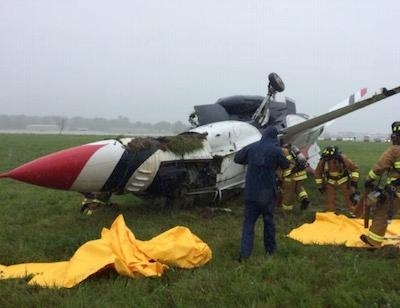Says Pilot Landed With Too Much Airspeed For Wet Runway Conditions
The U.S. Air Force Accident Investigation Board has released a final report from an accident which occurred on June 23, 2017 at Dayton (OH) International Airport (KDAY) involving an F-16 jet flying as part of the Thunderbirds demonstration team.

The aircraft was attempting to land on a wet runway following an orientation flight with two Air Force Personell on board. The mishap pilot (MP) sustained non-life-threatening injuries, while the mishap crewmember (MC) was uninjured, according to the report. There was no attempt to eject. Both personnel are assigned to the USAFADS. The mishap aircraft (MA), valued at $29,268,599, was destroyed.
The mishap occurred during a familiarization sortie for the MC, with the MP demonstrating the capabilities of the F-16 and the maneuvers performed by the USAFADS. The weather at KDAY was reported as broken at 900 feet, broken at 1,500 feet, and overcast at 2,500 feet; winds 340 at 17 knots, gusting to 20 knots; 1 ½ miles visibility with heavy rain and mist. Prior to landing, Dayton Tower advised MP there was previously reported wind shear and heavy precipitation at KDAY. MP executed a missed approach on the first approach to KDAY due to an inability to see the runway environment because of standing water on the canopy that obscured MP’s vision. MP received holding instructions from Columbus Approach Control to wait for the weather to clear at KDAY. After holding for approximately 30 minutes, MP proceeded on vectors to the Instrument Landing System (ILS) approach to KDAY Runway 6 Left (6L).

MP had adequate fuel to attempt one approach to KDAY then divert to Wilmington Airport if necessary. On MP’s final instrument approach to Runway 6L, MP again experienced standing water on the MA’s canopy, directly in front of the head-up display (HUD), obscuring the MP’s forward vision and blurring the HUD. MP considered the crosswinds and wind shear and planned to fly a faster approach of 160-165 knots. The Crash Survivable Flight Data Recorder (CSFDR) shows that MA maintained approximately 200 Knots Calibrated Airspeed (KCAS) on final approach. The MA crossed the runway approach end threshold at approximately 193 knots, 43 knots faster than the Technical Order calculated approach airspeed. This excess airspeed significantly increased the distance required to land the MA.
The MA landed on Runway 6L, approximately 4,764 feet down the wet runway, 25 knots above computed touchdown speed, leaving 6,137 feet of prepared surface available to stop the aircraft prior to the overrun. MP was unable to stop the MA on the prepared surface. MA entered the overrun at approximately 50 knots; 4 seconds later the MA departed the overrun and overturned in the grass.
The Accident Board President found by a preponderance of the evidence that the cause of the mishap was landing with excess airspeed and insufficient distance to stop the MA on the wet runway. Substantially contributing factors were environmental conditions affecting vision, misperception of changing environment, and procedures not followed correctly.
(Images provided with USAF Accident Board report)
 ANN's Daily Aero-Linx (05.02.24)
ANN's Daily Aero-Linx (05.02.24) ANN's Daily Aero-Term (05.02.24): Touchdown Zone Lighting
ANN's Daily Aero-Term (05.02.24): Touchdown Zone Lighting Aero-News: Quote of the Day (05.02.24)
Aero-News: Quote of the Day (05.02.24) ANN FAQ: Contributing To Aero-TV
ANN FAQ: Contributing To Aero-TV NTSB Final Report: Cirrus Design Corp SR20
NTSB Final Report: Cirrus Design Corp SR20




